When the morning is warm, the winds have calmed and a fine mist of fog shrouds the land, it’s fun to wax poetic and play with words in my mind; nature is waking up and inspiration is everywhere.
The distant call of unseen chachalacas and low grunts of a great blue heron at the resaca’s edge comfort like the companionship of a friend.
In the stillness of this early morning fog, flowers seem more vibrant — colors pop out of the haze with an intensity and vibrancy that sunshine sometimes washes out.
Perhaps the colors are more striking because of the way the fog crystals bend the ultraviolet rays — something for others to think about while I arrange words in my mind in fun orders.
My husband announced this week, “The mockingbirds are singing.” That, coupled with the sweet, heady scent of citrus blossoms, and a touch of spring fever, twigged my creative juices.
The Japanese have a traditional poem called haiku (pronounced, hi coo).
The mockingbird sings
Flitting in and out of shrubs
Winter turns to spring
Haiku is a three-line poem with 17 syllables. The count is five/seven/five. Traditionally, it focuses on images from nature and each poem should allude to or mention a season. Haiku is supposed to be simple, intense and direct.
Limericks are fun, too, although they take more effort to write since they’re longer — five lines instead of three, and they have to rhyme and make some sort of sense. You can’t make up words to make them rhyme. I recall a graduate class writing assignment in Spain, where we had to write 25 limericks before the next class. Once you get “in the zone,” it’s pretty easy if you can conjure up enough subjects.
There once was a bird who came knocking
At the shop door where I was working
He said to me fool
Shut off that loud tool
It’s the radio tune I am mocking
Limericks are fun five-line poems with a distinctive rhythm. The first, second and fifth lines contain 7 to 10 syllables and rhyme. The third and fourth lines have 5 to 7 syllables and rhyme with each other as in the silly example above. Limericks are silly. They’re written to elicit a laugh or an eye-rolling groan.
Only the male mockingbird sings, I learned during a birding lecture last year. The tunes he imitates may be of other birds, animals, insects, machinery and even musical instruments.
The mockingbird sings, news it brings, of spring — An itty-bitty-ditty that needs a catchy tune.
Others have waxed better-poetic than I about the ancient mockingbird. No matter how it sings, the singing mockingbird is a sign of spring here in the Deep South of Texas, where they are permanent residents.
I’ve noticed our mockingbirds dashing in and out of the shrubs this week. They may be after insects — they like to dart in, flick their wings to make the insects scatter, then feed up.
I suspect there’s a bit of nest building going on, too. Both sexes work to build the nest. Mockingbirds build low — between 3 and 10 feet above the ground. I’d like to encourage them to build higher, say in the tops of the mesquite, but they have tried and true methods of keeping cats away from their nests. They don’t need my advice.
Birds aren’t the only things singing of spring. Some flowers are so colorful, they fairly shimmer in their vibrancy in these fog-shrouded March mornings, like the mealy blue sage.
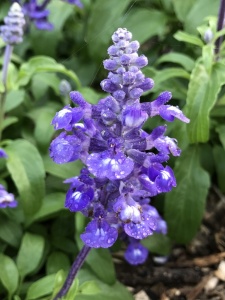
A Texas native, mealy blue sage, also mealycup sage (Salvia farniacea), is a perennial in the mint family.
It’s easily grown throughout southern portions of the U.S. It is drought tolerant – avoid wet areas; too much water will make them leggy.
Mine survived the December and January snow and freezes. They continued to keep their blooms, however pitiful they may have looked. But now they’re in a blooming frenzy! The plant is very attractive to butterflies, bees and hummingbirds.
Mealy blue sage like a sandy or gravelly soil and full sun. They are a fragrant plant to put in a grouping to create an attractive mass of deep purple.
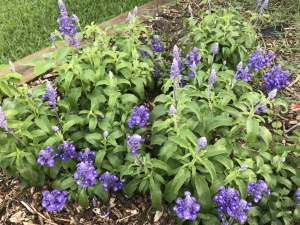
Another survivor of the Great Winter of The Freezing Temps is the delicate snapdragon vine (Maurandya antirrhiniflora). It’s a host plant for the common buckeye butterfly. These tiny vines readily self-propagate and do not kill, or otherwise strangle the plants and trees they intertwine. It’s not unusual to see hummingbirds visiting these flowers, too.
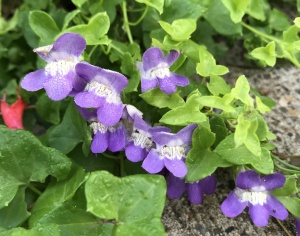
A native plant new to my yard this year has come up in an area that was cleared last year of old, tall, encroaching, out-of-control, non-native shrubs along our fence line.
It might be a Rio Grande mock vervain, Glandularia polyantha [Verbena polyantha] in the Verbenaceae family (Richardson/King book, Plants of Deep South Texas, vervains and verbinas pages 413-422).
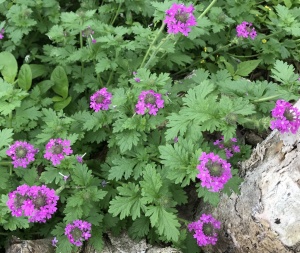
In another part of the yard, it was possibly a sleeper coming with a plant potted up from a friend’s yard. Vervain makes a great ground cover as the stems tend to sprawl and it blooms in all seasons.
It’s always surprising to see what comes up each spring. That’s one reason I like to encourage people to not mow or weed-eat too early. See what comes up from seeds long-undisturbed where possibly the soil hasn’t seen the sun for 25 years or so, as in the case of our cleared fence row.
Tiny Tim, Thymophylla tenuiloba, was a ride-along in a pot of gaura I purchased. Both have survived the cruel winter with the feathery spring-green leaves of Tiny Tim contrasting with its tiny yellow blooms. It’s too early for the gaura to bloom. Tiny Tim will quit blooming through the heat of summer and then bloom again in the fall.
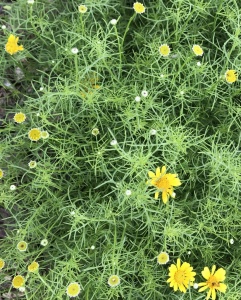
And my favorite: the dandelion — an announcement of spring, for me, from Kansas to England, Spain and up and down the eastern seaboard.
Our Valley native is called false dandelion, Pyrrhopappus pauciflorus. False or not, it still has the ability to show a happy face to the end of winter and give me cause to smile.
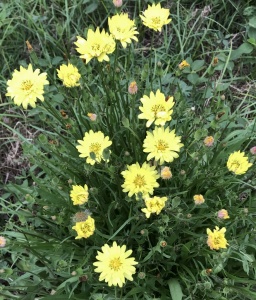
The common dandelion, Taraxacum officinale, is rare in southernmost Texas. I did manage to photograph one a couple of years ago that was growing next to a curb in the parking lot of Valley International Airport above North Ed Carey Drive in Harlingen.
Some old standards are always comforting. Like a favorite old song, pink evening primrose, buttercup, amapola del campo (which translates to wild poppy) — Oenothera speciosa, is always fun to find in the grass when you’re mowing — and easy to mow around while they show off their colors in early spring.
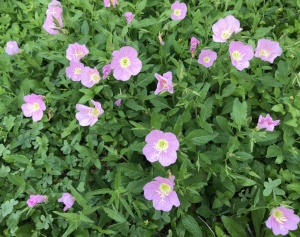
After the mist clears of a morning, hop in your car and take a drive around the countryside. Pay attention to the colorful native plants popping up alongside the road, butterflies teeming around anacua trees or birds singing. Try your hand at creating a poem, haiku or limerick and share it with us in the comments.
Great job, Anita, you helped me to identify 3 newbies to my alley and yard. mock vervain, primrose and snapdragon
Excellent, Greg! It’s always fun to discover newbies!